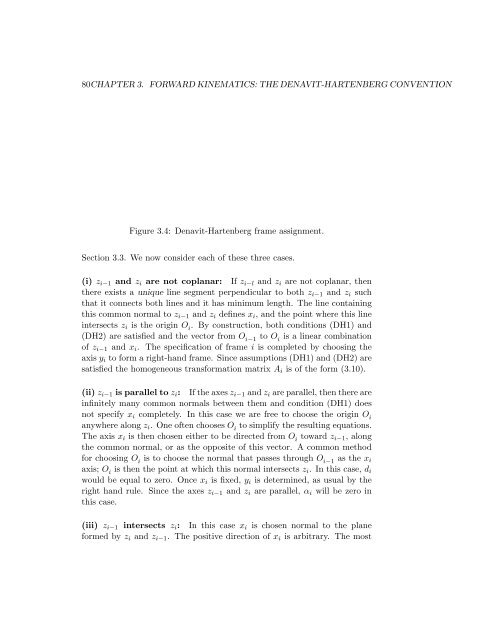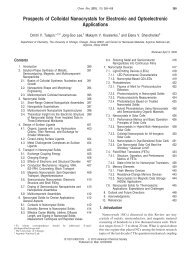FORWARD KINEMATICS: THE DENAVIT-HARTENBERG ...
FORWARD KINEMATICS: THE DENAVIT-HARTENBERG ...
FORWARD KINEMATICS: THE DENAVIT-HARTENBERG ...
You also want an ePaper? Increase the reach of your titles
YUMPU automatically turns print PDFs into web optimized ePapers that Google loves.
80CHAPTER 3. <strong>FORWARD</strong> <strong>KINEMATICS</strong>: <strong>THE</strong> <strong>DENAVIT</strong>-<strong>HARTENBERG</strong> CONVENTION<br />
Figure 3.4: Denavit-Hartenberg frame assignment.<br />
Section 3.3. We now consider each of these three cases.<br />
(i) zi−1 and zi are not coplanar: If zi−l and zi are not coplanar, then<br />
there exists a unique line segment perpendicular to both zi−1 and zi such<br />
that it connects both lines and it has minimum length. The line containing<br />
this common normal to zi−1 and zi defines xi, and the point where this line<br />
intersects zi is the origin O i . By construction, both conditions (DH1) and<br />
(DH2) are satisfied and the vector from O i−1 to O i is a linear combination<br />
of zi−1 and xi. The specification of frame i is completed by choosing the<br />
axis yi to form a right-hand frame. Since assumptions (DH1) and (DH2) are<br />
satisfied the homogeneous transformation matrix Ai is of the form (3.10).<br />
(ii) zi−1 is parallel to zi: If the axes zi−1 and zi are parallel, then there are<br />
infinitely many common normals between them and condition (DH1) does<br />
not specify xi completely. In this case we are free to choose the origin O i<br />
anywhere along zi. One often chooses O i to simplify the resulting equations.<br />
The axis xi is then chosen either to be directed from O i toward zi−1, along<br />
the common normal, or as the opposite of this vector. A common method<br />
for choosing O i is to choose the normal that passes through O i−1 as the xi<br />
axis; O i is then the point at which this normal intersects zi. In this case, di<br />
would be equal to zero. Once xi is fixed, yi is determined, as usual by the<br />
right hand rule. Since the axes zi−1 and zi are parallel, αi will be zero in<br />
this case.<br />
(iii) zi−1 intersects zi: In this case xi is chosen normal to the plane<br />
formed by zi and zi−1. The positive direction of xi is arbitrary. The most
















